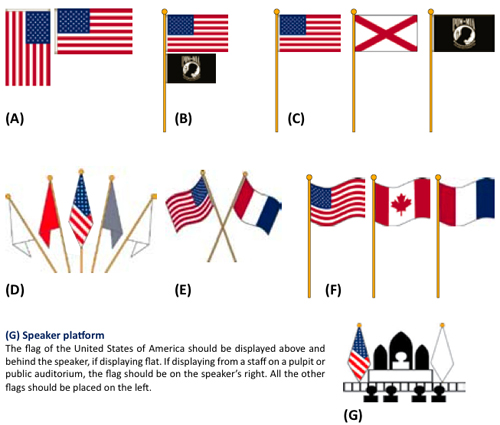Displaying the flag at half-staff
When flying the flag at half-staff, the flag should be raised to the top of the staff for an
instant then lowered to the mid‐way point of the staff (half-staff). It should be raised
to the top of the staff again before lowering the flag at the end of the day. The flag is
flown at half‐staff from sunrise until noon on Memorial Day. It is flown at full staff for the
remainder of the day.
In the event of the death of principal figures of the United States government and the
governor of the state, territory or possession, the President may order the flag to be
flown at half-staff as respect for their memory. In the event of the death of other officials
or foreign dignitaries, the flag is displayed at half-staff in accordance with recognized
customs or practices, not inconsistent with law.
The governor of a state, territory or possession of the United States may proclaim that
the national flag be flown at half-staff in the event of the death of a present or former
official of that state, territory or possession.
How long should a flag last?
How long any flag will last depends on the weather, its location, airborne contamination
and how often you fly your flag. Remember, your flag is a piece of cloth that works very,
very, hard. Throughout its lifetime your flag shakes, snaps, chafes, bakes, freezes, furls,
twists, flaps, flies, unfurls and hangs! Is it any wonder that a flag that flies continuously
needs replacing two or three times a year? No one can control the weather but you
can take some important steps to lengthen the life of your flag. Always let your flag dry
thoroughly before storing it to prevent mildew or color transfer. Also, at the first sign of
fraying, have your flag repaired before further damage is done.
When to fly the flag
Our national flag should be displayed on all days that there is no danger the weather
will damage it. This not only shows respect for our national symbol, but prolongs the
life of the flag. It is customary to fly the flag from sunrise to sunset on buildings or on a
stationary flagpole in the open. However, it may also be flown at night if it is properly
illuminated with a spotlight.

(A) Displaying other than on a staff
When displaying the flag against a wall, either horizontally or vertically, the union (blue field with 50 stars) should be upper most and to the observer's
left (the flag's own right). The union should also be to the observer's left when displaying the flag from a window.
|
(B) On the same halyard
When flying state, city, organizational or institutional flags from the same
halyard with the United States flag, the latter should always be at the
peak.
|
(C) From adjacent staffs
When flying from adjacent staffs, the United States flag should be hoisted
first and lowered last. Never fly any other flag or pennant above or to the
United States flag's right.
|
(D) In a group
When displaying in a group with state, city, organization or institutional
flags from staffs, the United States flag should be in the center and at the
highest point of the group.
|
(E) Crossed staffs
When displaying with any other flag from crossed staffs, the United States
flag should be on the right (the flag's own right) and its staff should be in
front of the other flag.
|
(F) With other nationís flags
When displaying two or more nationís flags, each flag should be on separate
staffs of the same height. The flags should be approximately the same size.
International customs forbid displaying one nation's flag over another in
times of peace. This is a sign of war time victory and a serious insult.
| |
|
|